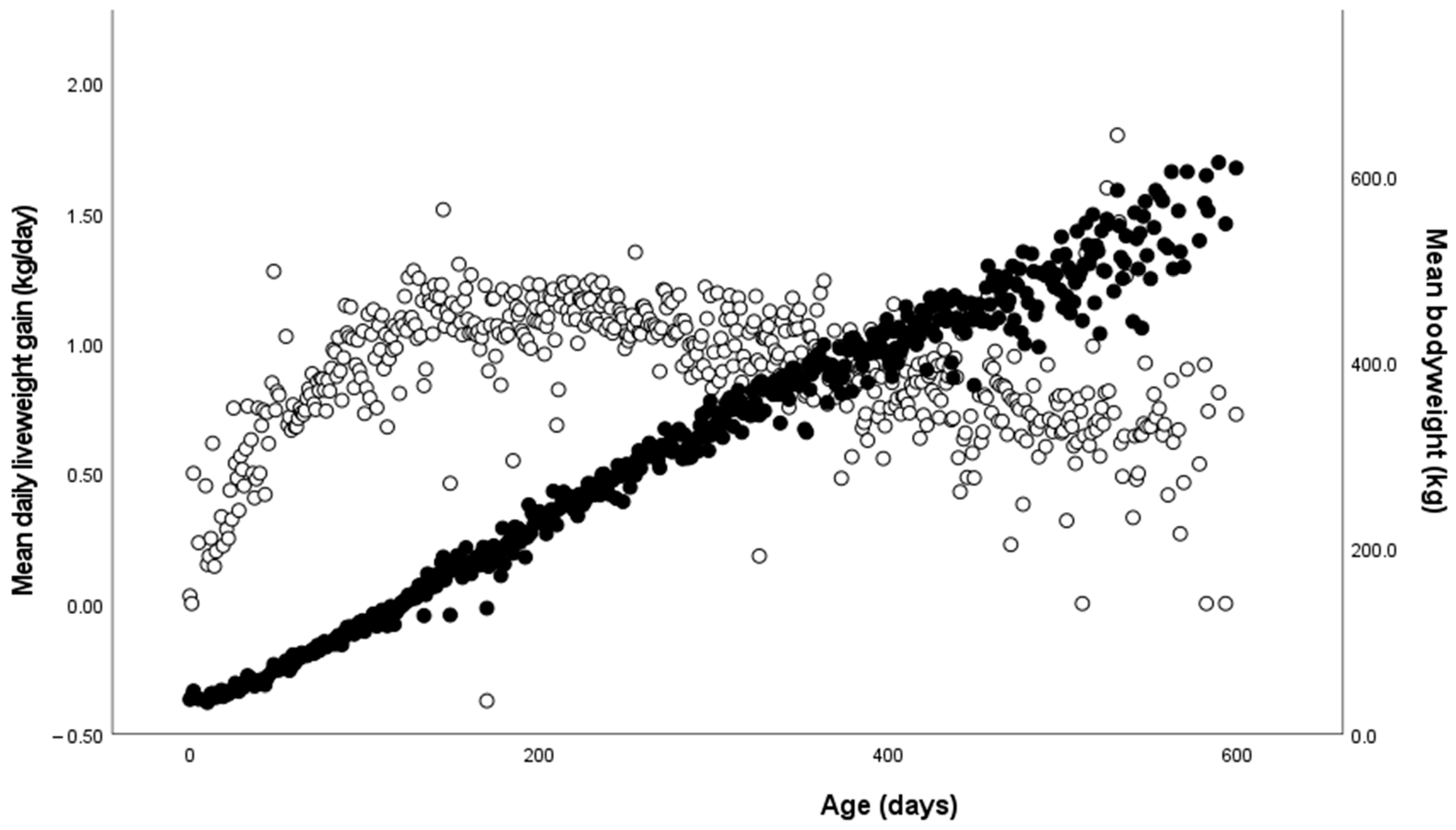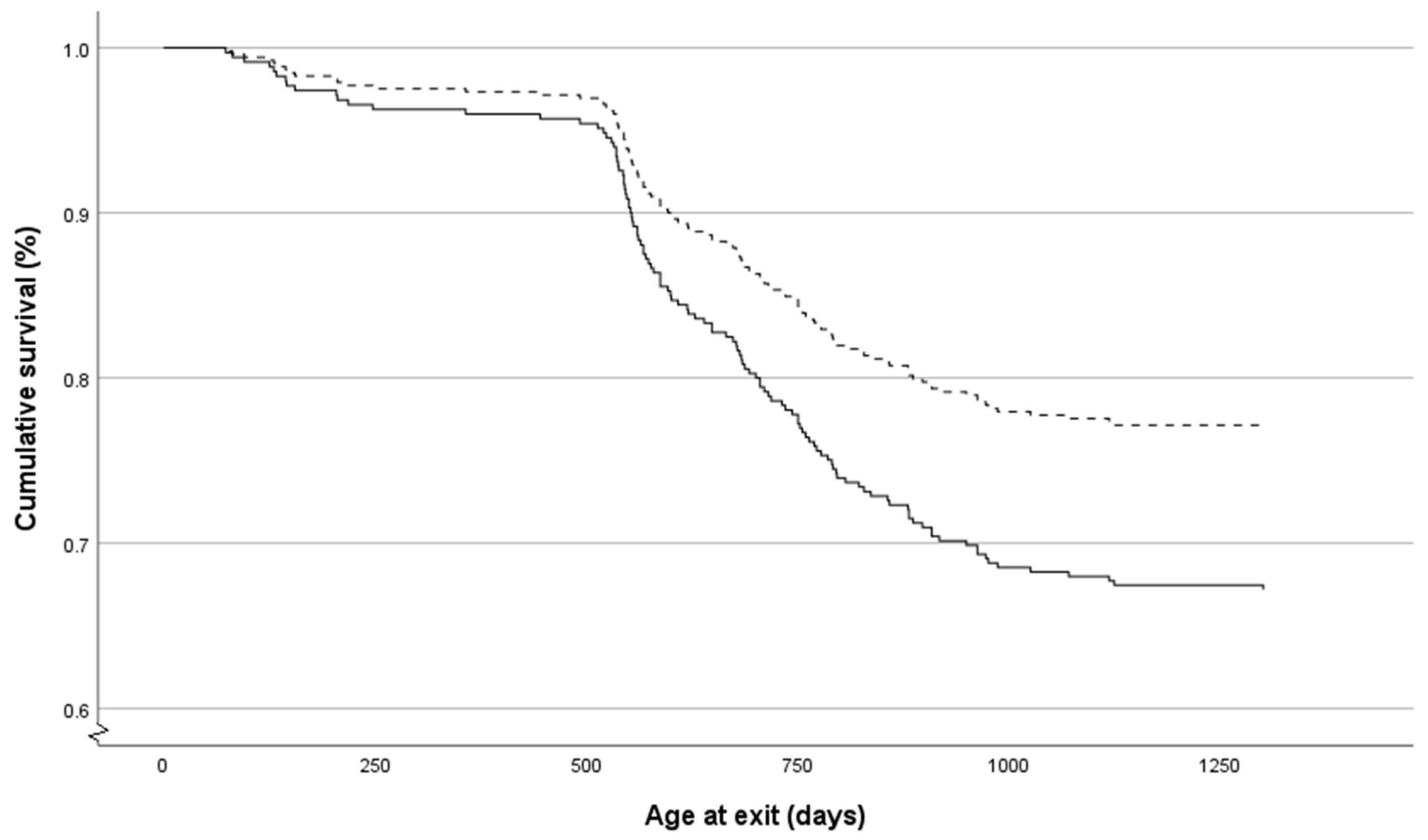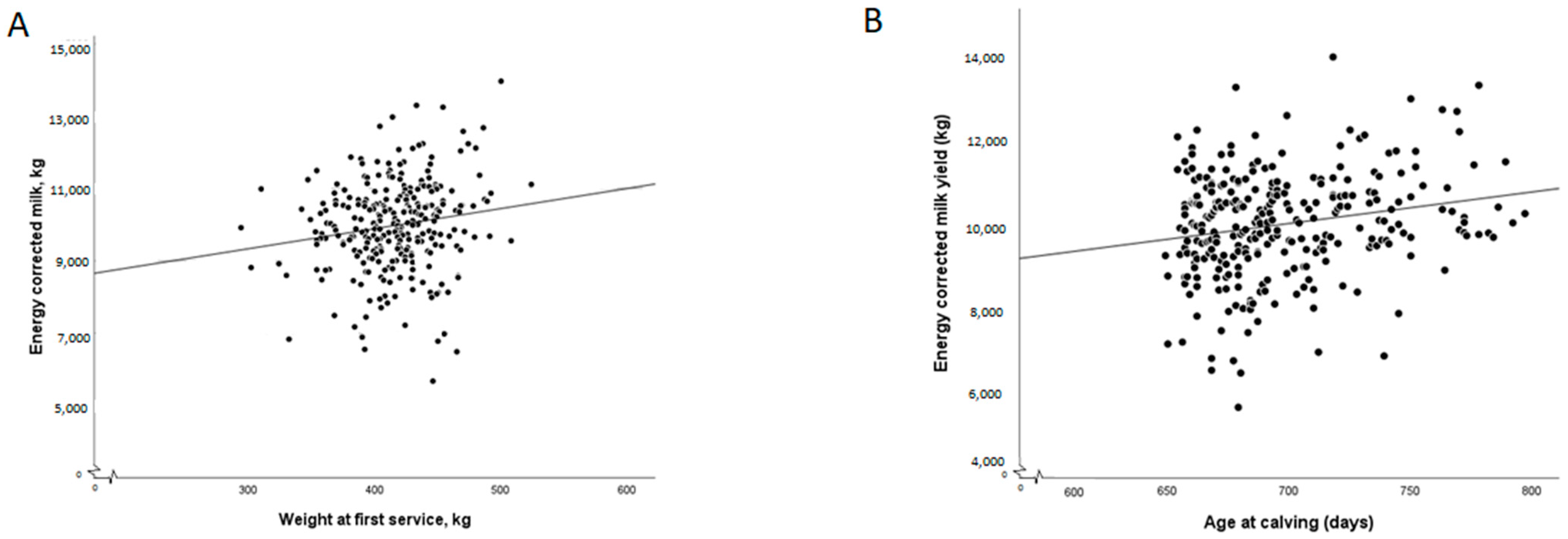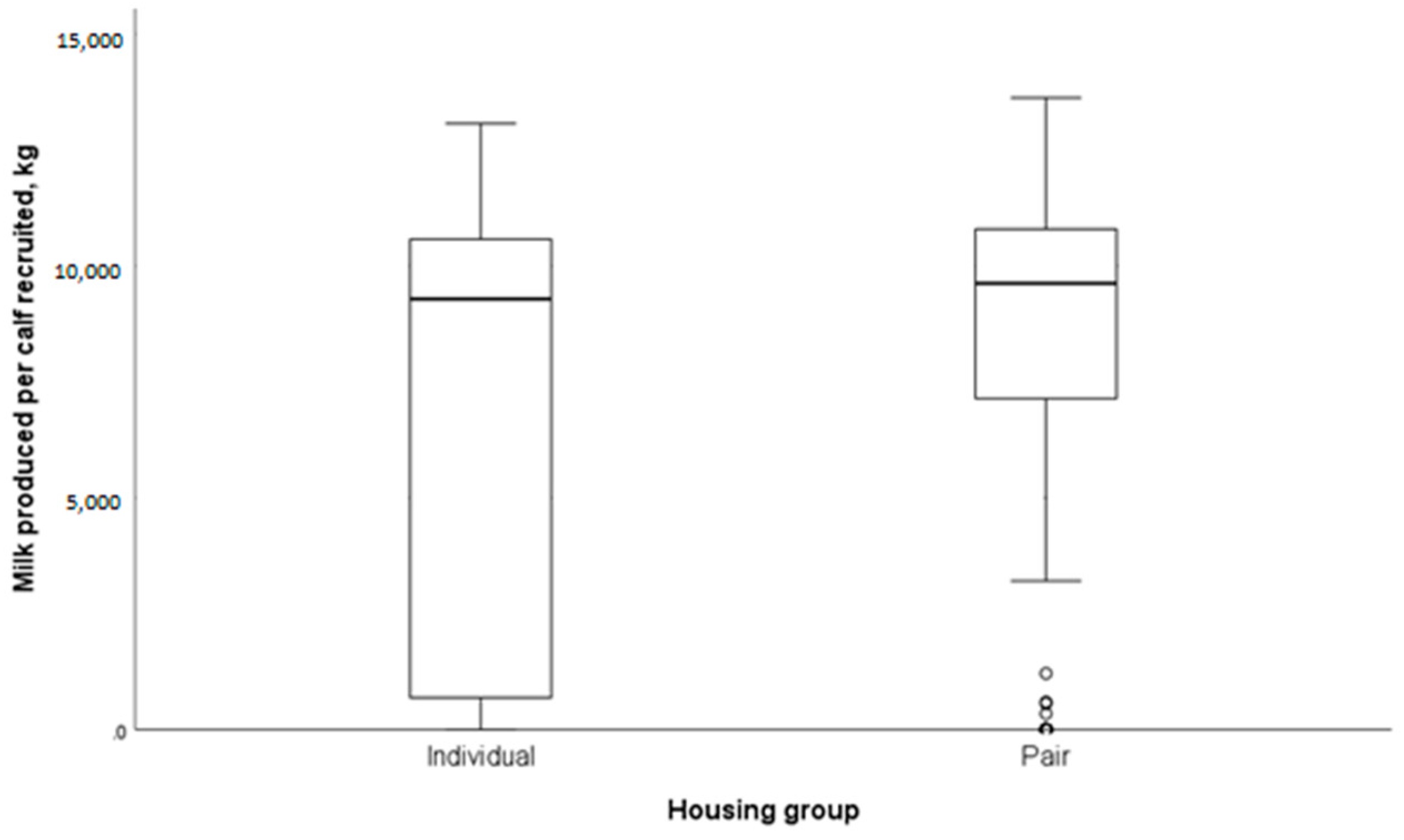Effects of the Individual and Pair Housing of Calves on Long-Term Heifer Production on a UK Commercial Dairy Farm
Abstract
Simple Summary
Abstract
1. Introduction
2. Materials and Methods
2.1. Calf Enrolment and Management
2.2. Post-Weaning Management, Breeding and Nutrition
2.3. Calves Born to Recruited Heifers
2.4. Statistical Analysis
3. Results
3.1. Daily Liveweight Gain
3.2. Mortality and Morbidity
3.3. Disease
3.4. Fertility
3.5. Milk Yield and Udder Health
3.6. First-Calf Vitality
4. Discussion
4.1. Mortality
4.2. Growth Rates
4.3. Fertility
4.4. Disease
4.5. Udder Health
5. Conclusions
Author Contributions
Funding
Institutional Review Board Statement
Informed Consent Statement
Data Availability Statement
Acknowledgments
Conflicts of Interest
Appendix A
| Model Type | Dependent Variables | Pen | Housing Group | Season of Birth | Birthweight | DLWG | Disease Pre-Weaning | Disease Post-Weaning | Disease (Exc. Udder Health) Post-Weaning | Disease Pre-Insemination | Age at First Insemination | Number of Inseminations | Bodyweight at First Insemination | Age at Calving |
|---|---|---|---|---|---|---|---|---|---|---|---|---|---|---|
| Cox regression | Survival | y | y | y | ||||||||||
| Generalised estimating equations | Disease (exc. udder health) from weaning to end of first lactation | y | y | y | y | y | ||||||||
| Udder health disease from weaning to end of first lactation | y | y | y | y | y | y | y | |||||||
| Successful pregnancy and parturition | y | y | y | y | y | y | y | y | ||||||
| Mortality rate of firstborn calves | y | y | y | y | y | y | y | |||||||
| Disease occurrence in firstborn calves | y | y | y | y | y | y | y | |||||||
| Linear mixed model | DLWG from birth to confirmation of pregancy | y | y | y | y | y | y | |||||||
| Number of inseminations given | y | y | y | y | y | y | y | y | ||||||
| Age at calving | y | y | y | y | y | y | y | |||||||
| Energy-corrected 305 d milk yield | y | y | y | y | y | y | y | y |
References
- De Paula Vieira, A.; von Keyserlingk, M.A.; Weary, D. Effects of Pair versus Single Housing on Performance and Behavior of Dairy Calves before and after Weaning from Milk. J. Dairy Sci. 2010, 93, 3079–3085. [Google Scholar] [CrossRef] [PubMed]
- Costa, J.H.C.; Meagher, R.K.; von Keyserlingk, M.A.G.; Weary, D.M. Early Pair Housing Increases Solid Feed Intake and Weight Gains in Dairy Calves. J. Dairy Sci. 2015, 98, 6381–6386. [Google Scholar] [CrossRef] [PubMed]
- Miller-Cushon, E.K.; DeVries, T.J. Effect of Social Housing on the Development of Feeding Behavior and Social Feeding Preferences of Dairy Calves. J. Dairy Sci. 2016, 99, 1406–1417. [Google Scholar] [CrossRef] [PubMed]
- Overvest, M.A.; Crossley, R.E.; Miller-Cushon, E.K.; DeVries, T.J. Social Housing Influences the Behavior and Feed Intake of Dairy Calves during Weaning. J. Dairy Sci. 2018, 101, 8123–8134. [Google Scholar] [CrossRef] [PubMed]
- Brickell, J.S.; Mcgowan, M.M.; Pfeiffer, D.U.; Wathes, D.C. Mortality in Holstein- Friesian Calves and Replacement Heifers, in Relation to Body Weight and IGF-I Concentration, on 19 Farms in England. Animal 2009, 3, 1175–1182. [Google Scholar] [CrossRef] [PubMed]
- Hoffman, P.C. Optimum Body Size of Holstein Replacement Heifers. J. Anim. Sci. 1997, 75, 836–845. [Google Scholar] [CrossRef] [PubMed]
- Shamay, A.; Werner, D.; Moallem, U.; Barash, H.; Bruckental, I. Effect of Nursing Management and Skeletal Size at Weaning on Puberty, Skeletal Growth Rate, and Milk Production during First Lactation of Dairy Heifers. J. Dairy Sci. 2005, 88, 1460–1469. [Google Scholar] [CrossRef]
- Wathes, D.C.; Pollott, G.E.; Johnson, K.F.; Richardson, H.; Cooke, J.S. Heifer Fertility and Carry over Consequences for Life Time Production in Dairy and Beef Cattle. Animal 2014, 8, 91–104. [Google Scholar] [CrossRef]
- Macdonald, K.A.; Penno, J.W.; Bryant, A.M.; Roche, J.R. Effect of Feeding Level Pre- and Post-Puberty and Body Weight at First Calving on Growth, Milk Production, and Fertility in Grazing Dairy Cows. J. Dairy Sci. 2005, 88, 3363–3375. [Google Scholar] [CrossRef]
- Hurst, T.S.; Neves, R.C.; Boerman, J.P. Early Life Indicators of First Lactation Milk Yield and the Effect of Treatment for Bovine Respiratory Disease on Survivability and Risk of Pregnancy in Holstein Dairy Cattle. Vet. J. 2022, 282, 105826. [Google Scholar] [CrossRef]
- Soberon, F.; Raffrenato, E.; Everett, R.W.; Van Amburgh, M.E. Preweaning Milk Replacer Intake and Effects on Long-Term Productivity of Dairy Calves. J. Dairy Sci. 2012, 95, 783–793. [Google Scholar] [CrossRef] [PubMed]
- Hayes, C.J.; McAloon, C.G.; Kelly, E.T.; Carty, C.I.; Ryan, E.G.; Mee, J.F.; O’Grady, L. The Effect of Dairy Heifer Pre-Breeding Growth Rate on First Lactation Milk Yield in Spring-Calving, Pasture-Based Herds. Animal 2021, 15, 100169. [Google Scholar] [CrossRef] [PubMed]
- Mahendran, S.A.; Wathes, D.C.; Booth, R.E.; Baker, N.; Blackie, N. Effects of Individual and Pair Housing of Calves on Short-Term Health and Behaviour on a UK Commercial Dairy Farm. Animals 2023, 13, 2140. [Google Scholar] [CrossRef] [PubMed]
- Morgan, C.K. Evaluation of Single vs. Pair Housing Holstein Calves on Specific Evaluation of Single vs. Pair Housing Holstein Calves on Specific Antibody Concentrations to KLH Antibody Concentrations to KLH.; University of Tennessee: Knoxville, TN, USA, 2018. [Google Scholar]
- McFarland, D. Calf Management: The Effect of Single and Paired Housing on Dairy Calf Health and Welfare. In Proceedings of the BCVA Cattle Practice, Telford, UK, 19–21 October 2023; Adams, J., Ed.; BCVA: Telford, UK, 2023; pp. 1–2. [Google Scholar]
- Mahendran, S.A.; Claire Wathes, D.; Booth, R.E.; Blackie, N. The Health and Behavioural Effects of Individual versus Pair Housing of Calves at Different Ages on a UK Commercial Dairy Farm. Animals 2021, 11, 612. [Google Scholar] [CrossRef] [PubMed]
- Curtis, G.; Argo, C.M.G.; Jones, D.; Grove-White, D. The Impact of Early Life Nutrition and Housing on Growth and Reproduction in Dairy Cattle. PLoS ONE 2018, 13, e0191687. [Google Scholar] [CrossRef] [PubMed]
- Donovan, G.A.; Dohoo, I.R.; Montgomery, D.M.; Bennett, F.L. Calf and Disease Factors Affecting Growth in Female Holstein Calves in Florida, USA. Prev. Vet. Med. 1998, 33, 1–10. [Google Scholar] [CrossRef] [PubMed]
- Fox, C.; Hammerman, P.; Thompson, C. Fuel Feeds Function: Energy Metabolism and the T-Cell Response. Nat. Rev. Immunol. 2005, 5, 844–854. [Google Scholar] [CrossRef]
- Quigley, J.D.; Wolfe, T.A.; Elsasser, T.H. Effects of Additional Milk Replacer Feeding on Calf Health, Growth, and Selected Blood Metabolites in Calves. J. Dairy Sci. 2006, 89, 207–216. [Google Scholar] [CrossRef]
- Abuelo, A.; Cullens, F.; Brester, J.L. Effect of Preweaning Disease on the Reproductive Performance and First-Lactation Milk Production of Heifers in a Large Dairy Herd. J. Dairy Sci. 2021, 104, 7008–7017. [Google Scholar] [CrossRef]
- Britney, J.B.; Martin, S.W.; Stone, J.B.; Curtis, R.A. Analysis of Early Calfhood Health Status and Subsequent Dairy Herd Survivorship and Productivity. Prev. Vet. Med. 1984, 3, 45–52. [Google Scholar] [CrossRef]
- Warnick, L.D.; Erb, H.N.; White, M.E. Lack of Association Between Calf Morbidity and Subsequent First Lactation Milk Production in 25 New York Holstein Herds. J. Dairy Sci. 1995, 78, 2819–2830. [Google Scholar] [CrossRef] [PubMed]
- Teixeira, A.G.V.; McArt, J.A.A.; Bicalho, R.C. Thoracic Ultrasound Assessment of Lung Consolidation at Weaning in Holstein Dairy Heifers: Reproductive Performance and Survival. J. Dairy Sci. 2017, 100, 2985–2991. [Google Scholar] [CrossRef] [PubMed]
- Burmeister, F.; Teuffert, J.; Schluter, H. Die Bedeutung Des Milchsaugens Für Die Eutergesundheit. Mh. Vet. Med. 1981, 36, 407–411. [Google Scholar]
- Pytloun, J. The Effect of Some Factors on Frequency of Mutual Sucking in Cows. Sci. Agric. Bohemoslov. 1985, 17, 125–130. [Google Scholar]
- Špinka, M. Intersucking in Dairy Heifers during the First Two Years of Life. Behav. Process. 1992, 28, 41–49. [Google Scholar] [CrossRef]
- Lidfors, L.; Isberg, L. Intersucking in Dairy Cattle—Review and Questionnaire. Appl. Anim. Behav. Sci. 2003, 80, 207–231. [Google Scholar] [CrossRef]
- Wood, P.D.; Smith, G.F.; Lisle, M.F. A Survey of Intersucking in Dairy Herds in England and Wales. Vet. Rec. 1967, 81, 396–398. [Google Scholar] [CrossRef] [PubMed]
- Keil, N.M.; Langhans, W. The Development of Intersucking in Dairy Calves around Weaning. Appl. Anim. Behav. Sci. 2001, 72, 295–308. [Google Scholar] [CrossRef]
- Debrecéni, O.; Juhás, P. Milk-Sucking in Dairy Cattle in Loose Housing in Slovakia. Livest. Prod. Sci. 1999, 61, 1–6. [Google Scholar] [CrossRef]
- Vavák, V. Ethological Regime and Frequency of Occurrence of Mutual Milk Sucking out in Cows from the Standpoint of Individual Pathoethology. Acta Zootech. 1990, 46, 187–197. [Google Scholar]
- Keil, N.M.; Audigé, L.; Langhans, W. Factors Associated with Intersucking in Swiss Dairy Heifers. Prev. Vet. Med. 2000, 45, 305–323. [Google Scholar] [CrossRef] [PubMed]
- De Passillé, A.M.; Borderas, F.; Rushen, J. Cross-Sucking by Dairy Calves May Become a Habit or Reflect Characteristics of Individual Calves More than Milk Allowance or Weaning. Appl. Anim. Behav. Sci. 2011, 133, 137–143. [Google Scholar] [CrossRef]
- Keil, N.M.; Audigé, L.; Langhans, W. Is Intersucking in Dairy Cows the Continuation of a Habit Developed in Early Life? J. Dairy Sci. 2001, 84, 140–146. [Google Scholar] [CrossRef] [PubMed]
- Fetrow, J.; Nordlund, K.V.; Norman, H.D. Invited Review: Culling: Nomenclature, Definitions, and Recommendations. J. Dairy Sci. 2006, 89, 1896–1905. [Google Scholar] [CrossRef]
- Overton, M.W.; Dhuyvetter, K.C. Symposium Review: An Abundance of Replacement Heifers: What Is the Economic Impact of Raising More than Are Needed? J. Dairy Sci. 2020, 103, 3828–3837. [Google Scholar] [CrossRef] [PubMed]
- Boulton, A.C.; Rushton, J.; Wathes, D.C. An Empirical Analysis of the Cost of Rearing Dairy Heifers from Birth to First Calving and the Time Taken to Repay These Costs. Animal 2017, 11, 1372–1380. [Google Scholar] [CrossRef] [PubMed]
- Lyu, J.; Wang, C.; Zhao, X.; Miao, E.; Wang, Z.; Xu, Y.; Bai, X.; Bao, J. Effect of Group Size and Regrouping on Physiological Stress and Behavior of Dairy Calves. J. Integr. Agric. 2023, 22, 844–852. [Google Scholar] [CrossRef]
- Raussi, S.; Niskanen, S.; Siivonen, J.; Hänninen, L.; Hepola, H.; Jauhiainen, L.; Veissier, I. The Formation of Preferential Relationships at Early Age in Cattle. Behav. Process. 2010, 84, 726–731. [Google Scholar] [CrossRef]
- Jensen, M.B.; Larsen, L.E. Effects of Level of Social Contact on Dairy Calf Behavior and Health. J. Dairy Sci. 2014, 97, 5035–5044. [Google Scholar] [CrossRef]
- Rushen, J.; De Passillé, A.M.B.; Munksgaard, L. Fear of People by Cows and Effects on Milk Yield, Behavior, and Heart Rate at Milking. J. Dairy Sci. 1999, 82, 720–727. [Google Scholar] [CrossRef]
- McGuirk, S. Troubleshooting Dairy Calf Pneumonia Problems. In Proceedings of the Twenty fifth Annual ACVIM Forum, Seattle, WA, USA, 6–9 June 2007. [Google Scholar]
- Mahendran, S.A.; Booth, R.; Burge, M.; Bell, N.J. Randomised Positive Control Trial of NSAID and Antimicrobial Treatment for Calf Fever Caused by Pneumonia. Vet. Rec. 2017, 181, 45. [Google Scholar] [CrossRef] [PubMed]
- AHDB Mobility Scoring: How to Score Your Cows. Available online: https://ahdb.org.uk/knowledge-library/mobility-scoring-how-to-score-your-cows (accessed on 18 October 2023).
- IFCN. IFCN Methods; IFCN: Kiel, Germany, 2023. [Google Scholar]
- Brickell, J.S.; Wathes, D.C. A Descriptive Study of the Survival of Holstein-Friesian Heifers through to Third Calving on English Dairy Farms. J. Dairy Sci. 2011, 94, 1831–1838. [Google Scholar] [CrossRef] [PubMed]
- Veissier, I.; Gesmier, V.; Le Neindre, P.; Gautier, J.Y.; Bertrand, G. The Effects of Rearing in Individual Crates on Subsequent Social Behaviour of Veal Calves. Appl. Anim. Behav. Sci. 1994, 41, 199–210. [Google Scholar] [CrossRef]
- Sood, P.; Nanda, A.S. Effect of Lameness on Estrous Behavior in Crossbred Cows. Theriogenology 2006, 66, 1375–1380. [Google Scholar] [CrossRef] [PubMed]
- Bazeley, K.J.; Barrett, D.C.; Williams, P.D.; Reyher, K.K. Measuring the Growth Rate of UK Dairy Heifers to Improve Future Productivity. Vet. J. 2016, 212, 9–14. [Google Scholar] [CrossRef] [PubMed][Green Version]
- Gibson, M.; Hickson, R.; Back, P.; Dittmer, K.; Schreurs, N.; Rogers, C. The Effect of Sex and Age on Bone Morphology and Strength in the Metacarpus and Humerus in Beef-Cross-Dairy Cattle. Animals 2021, 11, 694. [Google Scholar] [CrossRef] [PubMed]
- Swali, A.; Wathes, D.C. Influence of the Dam and Sire on Size at Birth and Subsequent Growth, Milk Production and Fertility in Dairy Heifers. Theriogenology 2006, 66, 1173–1184. [Google Scholar] [CrossRef]
- Donovan, G.A.; Dohoo, I.R.; Montgomery, D.M.; Bennett, F.L. Associations between Passive Immunity and Morbidity and Mortality in Dairy Heifers in Florida, USA. Prev. Vet. Med. 1998, 34, 31–46. [Google Scholar] [CrossRef]
- Babu, L.K.; Pandey, H.N.; Sahoo, A. Effect of Individual versus Group Rearing on Ethological and Physiological Responses of Crossbred Calves. Appl. Anim. Behav. Sci. 2004, 87, 177–191. [Google Scholar] [CrossRef]
- Reuscher, K.J.; Salter, R.S.; da Silva, T.E.; Van Os, J.M.C. Comparison of Behavior, Thermoregulation, and Growth of Pair- vs. Individually Housed Calves in Outdoor Hutches during Continental Wintertime. J. Dairy Sci. 2023; in press. [Google Scholar] [CrossRef]
- Jorgensen, M.W.; Adams-Progar, A.; de Passillé, A.M.; Rushen, J.; Godden, S.M.; Chester-Jones, H.; Endres, M.I. Factors Associated with Dairy Calf Health in Automated Feeding Systems in the Upper Midwest United States. J. Dairy Sci. 2017, 100, 5675–5686. [Google Scholar] [CrossRef]
- van Leenen, K.; Jouret, J.; Demeyer, P.; Van Driessche, L.; De Cremer, L.; Masmeijer, C.; Boyen, F.; Deprez, P.; Pardon, B. Associations of Barn Air Quality Parameters with Ultrasonographic Lung Lesions, Airway Inflammation and Infection in Group-Housed Calves. Prev. Vet. Med. 2020, 181, 105056. [Google Scholar] [CrossRef] [PubMed]
- Louie, A.P.; Rowe, J.D.; Love, W.J.; Lehenbauer, T.W.; Aly, S.S. Effect of the Environment on the Risk of Respiratory Disease in Preweaning Dairy Calves during Summer Months. J. Dairy Sci. 2018, 101, 10230–10247. [Google Scholar] [CrossRef] [PubMed]
- Brickell, J.S.; McGowan, M.M.; Wathes, D.C. Effect of Management Factors and Blood Metabolites during the Rearing Period on Growth in Dairy Heifers on UK Farms. Domest. Anim. Endocrinol. 2009, 36, 67–81. [Google Scholar] [CrossRef] [PubMed]
- Lauber, M.R.; Fricke, P.M. The Association between Insemination Eligibility and Reproductive Performance of Nulliparous Heifers on Subsequent Body Weight and Milk Production of Primiparous Holstein Cows. JDS Commun. 2023, 4, 428–432. [Google Scholar] [CrossRef] [PubMed]
- Han, L.; Heinrichs, A.J.; De Vries, A.; Dechow, C.D. Relationship of Body Weight at First Calving with Milk Yield and Herd Life. J. Dairy Sci. 2021, 104, 397–404. [Google Scholar] [CrossRef] [PubMed]
- Handcock, R.C.; Lopez-Villalobos, N.; McNaughton, L.R.; Back, P.J.; Edwards, G.R.; Hickson, R.E. Positive Relationships between Body Weight of Dairy Heifers and Their First-Lactation and Accumulated Three-Parity Lactation Production. J. Dairy Sci. 2019, 102, 4577–4589. [Google Scholar] [CrossRef] [PubMed]
- Heinrichs, A.J.; Heinrichs, B.S. A Prospective Study of Calf Factors Affecting First-Lactation and Lifetime Milk Production and Age of Cows When Removed from the Herd1. J. Dairy Sci. 2011, 94, 336–341. [Google Scholar] [CrossRef]
- Mahendran, S.A.; Booth, R.; Beekhuis, L.; Manning, A.; Blackmore, T.; Vanhoudt, A.; Bell, N. Assessing the Effects of Weekly Preweaning Health Scores on Dairy Calf Mortality and Productivity Parameters: Cohort Study. Vet. Rec. 2017, 181, 196. [Google Scholar] [CrossRef]
- Persson Waller, K.; Lundberg; Nyman, A.K. Risk and Success Factors for Good Udder Health of Early Lactation Primiparous Dairy Cows. J. Dairy Sci. 2021, 104, 4858–4874. [Google Scholar] [CrossRef]
- Sheridan, J.F.; Dobbs, C.; Brown, D.; Zwilling, B. Psychoneuroimmunology: Stress Effects on Pathogenesis and Immunity during Infection. Clin. Microbiol. Rev. 1994, 7, 200–212. [Google Scholar] [CrossRef]
- Vaughan, A.; Miguel-Pacheco, G.G.; Marie de Passillé, A.; Rushen, J. Reciprocated Cross Sucking between Dairy Calves after Weaning off Milk Does Not Appear to Negatively Affect Udder Health or Production. J. Dairy Sci. 2016, 99, 5596–5603. [Google Scholar] [CrossRef] [PubMed]
- Mahmoud, M.E.; Mahmoud, F.A.; Ahmed, A.E. Impacts of Self- and Cross-Sucking on Cattle Health and Performance. Vet. World 2016, 9, 922. [Google Scholar] [CrossRef] [PubMed]





| Birth to Weaning | Weaning to 10 Months | 10 to 15 Months | 16 to 22 Months | Lactating Primiparous Cow Ration | |
|---|---|---|---|---|---|
| Crude protein, % | 15.8 | 15.8 | 15.0 | 11.5 | 17.5 |
| Starch, % | 13.9 | 13.9 | 15.6 | 7.7 | 24.8 |
| Expected intake, kg/day (dry matter intake, kg/day) | Ad libitum | 11.3 (6.9) | 19.2 (7.3) | 34.3 (9.5) | 68.0 (27.3) |
| Ingredients | Grass silage, chopped wheat straw, caustic wheat, mineral mix and rapeseed meal | Grass silage, chopped wheat straw, caustic wheat, mineral mix and rapeseed meal | Grass silage, chopped wheat straw, caustic wheat, waste bread, 18% heifer rearer nut, mineral mix and rapeseed meal | Grass silage, chopped wheat straw, caustic wheat, waste bread, 18% heifer rearer nut, mineral mix and rapeseed meal | Grass and maize silage, waste bread, caustic wheat and a mineral mix |
| Disease/Condition | Total (%) | Individually Housed (%) | Pair-Housed (%) |
|---|---|---|---|
| Lameness | 104/418 (24.9) | 44/148 (29.7) # | 60/270 (22.2) # |
| Clinical mastitis | 83/418 (19.9) | 18/148 (12.1) * | 65/270 (24.1) * |
| Respiratory disease | 79/418 (18.9) | 24/148 (16.2) | 53/270 (19.6) |
| Miscellaneous 1 | 16/418 (3.8) | 2/148 (1.4) | 20/270 (7.4) |
| High SCC 2 | 25/418 (6.0) | 6/148 (4.1) | 19/270 (7.0) |
| Injury | 26/418 (6.2) | 11/148 (7.4) | 15/270 (5.6) |
| Diarrhoea | 7/418 (1.7) | 3/148 (1.8) | 4/270 (1.5) |
| Individually Housed | Pair-Housed | |
|---|---|---|
| Number of animals | 142 | 264 |
| Mean age at first insemination (SD), days | 396 (12.5) | 399 (27.8) |
| Mean number of inseminations (SD, range) | 2.5 (1.7, 1–7) | 2.5 (1.5, 1–7) |
| Mean DLWG until pregnancy (SD), kg/day | 0.73 (0.13) | 0.72 (0.12) |
| Mean bodyweight at first insemination (SD, range), kg | 417 (34.8, 340–524) | 417 (31.4, 330–500) |
| Mean age at first calving (SD), days | 698.2 (34.0) | 697.8 (35.1) |
Disclaimer/Publisher’s Note: The statements, opinions and data contained in all publications are solely those of the individual author(s) and contributor(s) and not of MDPI and/or the editor(s). MDPI and/or the editor(s) disclaim responsibility for any injury to people or property resulting from any ideas, methods, instructions or products referred to in the content. |
© 2023 by the authors. Licensee MDPI, Basel, Switzerland. This article is an open access article distributed under the terms and conditions of the Creative Commons Attribution (CC BY) license (https://creativecommons.org/licenses/by/4.0/).
Share and Cite
Mahendran, S.A.; Wathes, D.C.; Booth, R.E.; Blackie, N. Effects of the Individual and Pair Housing of Calves on Long-Term Heifer Production on a UK Commercial Dairy Farm. Animals 2024, 14, 125. https://doi.org/10.3390/ani14010125
Mahendran SA, Wathes DC, Booth RE, Blackie N. Effects of the Individual and Pair Housing of Calves on Long-Term Heifer Production on a UK Commercial Dairy Farm. Animals. 2024; 14(1):125. https://doi.org/10.3390/ani14010125
Chicago/Turabian StyleMahendran, Sophie A., D. Claire Wathes, Richard E. Booth, and Nicola Blackie. 2024. "Effects of the Individual and Pair Housing of Calves on Long-Term Heifer Production on a UK Commercial Dairy Farm" Animals 14, no. 1: 125. https://doi.org/10.3390/ani14010125
APA StyleMahendran, S. A., Wathes, D. C., Booth, R. E., & Blackie, N. (2024). Effects of the Individual and Pair Housing of Calves on Long-Term Heifer Production on a UK Commercial Dairy Farm. Animals, 14(1), 125. https://doi.org/10.3390/ani14010125






